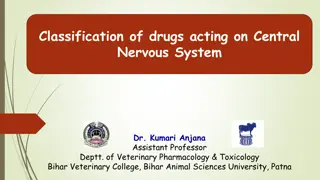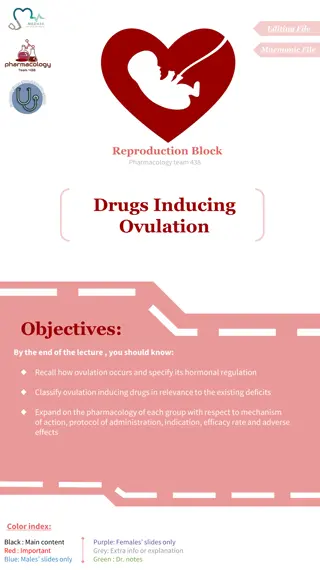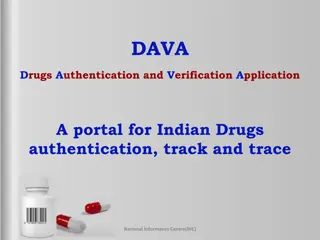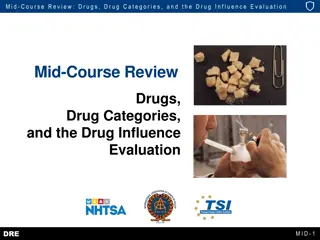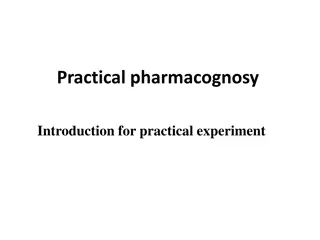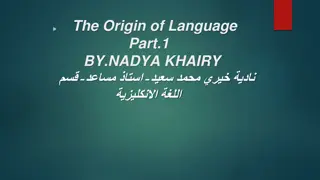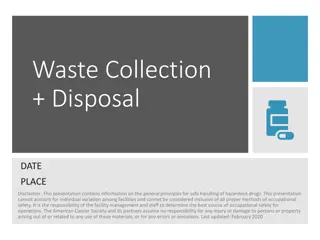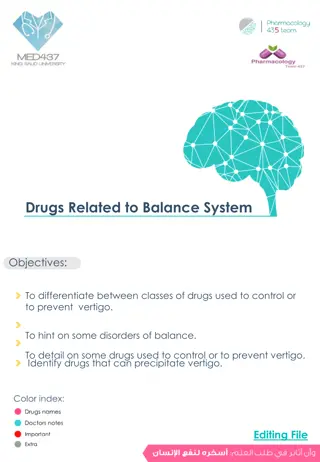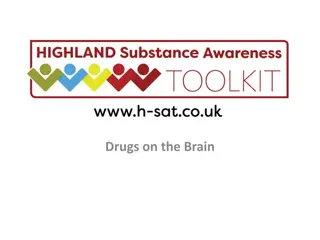Sources of Drugs and Their Origins
Drugs can be sourced from six major categories: plants, animals, minerals/earth, microbiological sources, semi-synthetic sources, synthetic sources, and recombinant DNA technology. Plant sources, being the oldest, provide various medicinal properties through leaves, flowers, fruits, seeds, roots, bark, and stem. Animal sources yield substances like insulin, hCG, thyroxin, and vitamins, while mineral sources offer elements like iron, zinc, and mercurial salts for treatment. The diverse origins of drugs showcase the natural diversity harnessed for medicinal purposes.
Download Presentation

Please find below an Image/Link to download the presentation.
The content on the website is provided AS IS for your information and personal use only. It may not be sold, licensed, or shared on other websites without obtaining consent from the author. Download presentation by click this link. If you encounter any issues during the download, it is possible that the publisher has removed the file from their server.
E N D
Presentation Transcript
Drugs are obtained from six major sources: Plant sources Animal sources Mineral/ Earth sources Microbiological sources Semi synthetic sources/ Synthetic sources Recombinant DNA technology
Plant Sources: Plant source is the oldest source of drugs. Most of the drugs in ancient times were derived from plants. Almost all parts of the plants are used i.e. leaves, stem, bark, fruits and roots. Leaves: The leaves of Digitalis Purpurea are the source of Digitoxin and Digoxin, which are cardiac glycosides. b. Leaves of Eucalyptus give oil of Eucalyptus, which is important component of cough syrup. c. Tobacco leaves give nicotine. d. Atropa belladonna gives atropine. a.
Flowers: Poppy papaver somniferum gives morphine (opoid) Vinca rosea gives vincristine and vinblastine Rose gives rose water used as tonic. Fruits: Senna pod gives anthracine, which is a purgative (used in constipation) Calabar beans give physostigmine, cholinomimetic agent. Seeds: Seeds of Nux Vomica give strychnine, which is a CNS stimulant. Castor oil seeds give castor oil. Calabar beans give Physostigmine, which is a cholinomimetic drug. which is
Roots: Ipecacuanha vomiting amoebicidal properties. Rauwolfia serpentina gives reserpine, a to also induce has root in gives accidental Emetine, poisoning. used as It hypotensive agent. Reserpine was used for hypertension treatment. Bark: Cinchona bark gives quinine and quinidine, which are antimalarial drugs. Quinidine also has antiarrythmic properties. Atropa belladonna anticholinergic. Hyoscyamus Niger gives anticholinergic. Stem: Chondrodendron tomentosum gives tuboqurarine, which is skeletal muscle relaxant used in general anesthesia. gives atropine, which is Hyosine, which is also
2. Animal Sources: Pancreas is a source of Insulin, used in treatment of Diabetes. Urine of pregnant women gives human chorionic gonadotropin (hCG) used for the treatment of infertility. Sheep thyroid is a source of thyroxin, used in hypertension. Cod liver is used as a source of vitamin A and D. Anterior pituitary is gonadotropins, used in treatment of infertility. Stomach tissue contains pepsin and trypsin, which are digestive juices used in treatment of peptic diseases in the past. Nowadays better drugs have replaced them. a source of pituitary Blood of animals is used in preparation of vaccines.
3. Mineral Sources: i. Metallic and Non metallic sources: Iron is used in treatment of iron deficiency anemia. Mercurial salts are used in Syphilis. Zinc is used as zinc supplement. Zinc oxide paste is used in wounds and in eczema. Iodine is antiseptic. Iodine supplements are also used. Gold salts are used in the treatment of rheumatoid arthritis.
ii. Miscellaneous Sources: Fluorine has antiseptic properties. Borax has antiseptic properties as well. Selenium as selenium sulphide is used in anti dandruff shampoos. Petroleum is used in preparation of liquid paraffin.
4. Synthetic/ Semi synthetic Sources: i. Synthetic Sources: When the nucleus of the drug from natural source as well as its chemical structure is altered, we call it synthetic. Examples include Emetine Bismuth Iodide ii. Semi Synthetic Source: When the nucleus of drug obtained from natural source is retained but the chemical structure is altered, we call it semi-synthetic. Examples include Apomorphine, Diacetyl morphine, Ethinyl Estradiol, Homatropine, Ampicillin and Methyl testosterone. Most of the drugs used nowadays (such as antianxiety drugs, anti convulsants) are semisynthetic forms.
5. Microbiological Sources: Penicillium notatum is a fungus which gives penicillin. Actinobacteria give Streptomycin. Aminoglycosides such as gentamicin and tobramycin are streptomycis and micromonosporas. obtained from
6. Recombinant DNA technology: Recombinant DNA technology involves cleavage of DNA by enzyme restriction endonucleases. The desired gene is coupled to rapidly replicating DNA (viral, bacterial or plasmid). The new genetic combination is inserted into the bacterial cultures which allow production of vast amount of genetic material. Advantages: It is less antigenic. Disadvantages: It is a complex and complicated technique. Huge amounts of drugs can be produced. Drug can be obtained in pure form. Well equipped lab is required. Highly trained staff is required.














